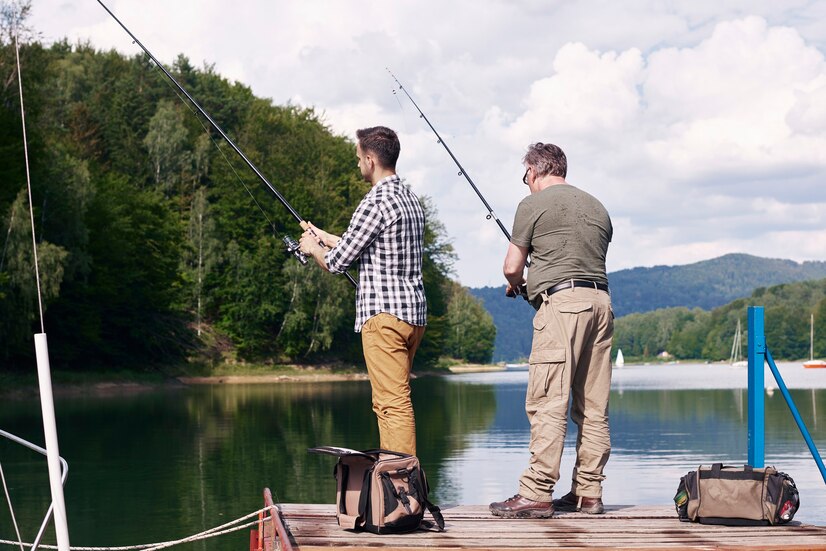
Fiskning, an age-old practice, has evolved into a multifaceted activity enjoyed by many around the world. This article explores its rich history, diverse techniques, and the essential gear needed for a successful trip. From ancient methods to modern advancements, fiskning offers a unique blend of tradition and innovation. Whether you’re drawn to the serenity of a quiet lake or the thrill of deep-sea adventures, there’s something for every enthusiast. Join us as we uncover the various aspects of fiskning and discover its environmental, social, and health benefits.
The Origins of Fiskning
Fiskning, one of humanity’s oldest subsistence activities, traces its roots back thousands of years. Early humans depended on fishing as a primary source of food, employing basic yet effective techniques. Archaeological findings reveal that ancient communities used sharpened sticks and rudimentary nets made from plant fibers to catch fish. These early tools were the foundation of what would become a sophisticated and varied practice.

Ancient Fishing Techniques
In ancient times, fishing methods were simple but ingenious. Spears and harpoons, crafted from wood and bone, were commonly used for their ease of use and effectiveness in shallow waters. Early fishers would often wade into rivers and lakes, spear in hand, waiting for the right moment to strike. This method required skill and patience, reflecting the fisher’s deep understanding of their environment.
Net fishing also dates back to prehistoric times. Nets were often woven from vines or grasses and strategically placed in streams to trap fish swimming downstream. This passive technique allowed communities to catch large quantities of fish with minimal effort. Over time, these nets evolved in complexity, incorporating weights and floats to improve their efficiency.
Historical Context and Early Methods
As societies evolved, so did their fishing methods. Ancient Egyptians, for example, are known for their depictions of fishing in the Nile River, showcasing the use of nets, traps, and lines. The Greeks and Romans made significant contributions, introducing more advanced tools like fish hooks made from bronze and iron. These civilizations also documented their fishing techniques extensively, providing valuable insights into the practices of the time.
In Asia, particularly in China and Japan, fishing developed unique cultural significance. The Chinese used cormorant birds to catch fish, a practice that involved training the birds to dive and retrieve fish, demonstrating an early form of animal-assisted fishing. In Japan, traditional methods such as “ukai” or cormorant fishing have been preserved and are still practiced today, highlighting the enduring legacy of ancient techniques.
Indigenous cultures around the world also developed specialized fishing methods suited to their environments. Native American tribes in North America, for instance, created fish weirs—barriers placed in rivers to direct fish into traps or enclosures. This communal effort not only provided food but also strengthened social bonds within the tribe.
Development Over Centuries
Throughout history, fishing continued to adapt and improve. The Middle Ages saw the introduction of fishing reels in China, which eventually spread to Europe. These reels allowed fishers to cast their lines farther and retrieve them more efficiently, marking a significant advancement in fishing technology.
By the Renaissance, fishing had become a popular pastime among the European nobility, leading to the development of more refined equipment and techniques. Fly fishing, which involves using artificial flies to lure fish, became particularly popular in England and Scotland. This method requires a high level of skill and artistry, reflecting the growing sophistication of fishing practices.
The Industrial Revolution brought about significant changes, with the mass production of fishing gear making it more accessible to the general population. Innovations such as steam-powered trawlers revolutionized commercial fishing, allowing for larger catches and the exploration of deeper waters. However, these advancements also led to overfishing and the depletion of fish stocks, highlighting the need for sustainable practices.
Traditional vs. Modern Methods
Comparing ancient fishing techniques to modern methods reveals a fascinating evolution. While the basic principles of fishing remain unchanged, technological advancements have dramatically transformed the practice. Modern fishers use sophisticated equipment like sonar and GPS to locate fish, increasing efficiency and success rates. Materials such as carbon fiber and high-strength polymers have replaced traditional wood and bone, making gear lighter and more durable.
Despite these advancements, many traditional techniques are still valued for their simplicity and connection to nature. Fly fishing, spearfishing, and net fishing continue to be practiced by enthusiasts who appreciate the skill and patience required. These methods also serve as a reminder of the rich cultural heritage and history of fiskning.
Freshwater and Saltwater Fiskning
Fishing, or fiskning, encompasses a wide range of environments and methods, each with its own unique appeal and challenges. Broadly, fiskning can be divided into two main categories: freshwater and saltwater fishing. Each type offers distinct experiences, techniques, and opportunities for anglers.
Freshwater Fiskning
Freshwater fishing takes place in non-saline bodies of water such as rivers, lakes, and ponds. This type of fishing is often more accessible, making it popular among both beginners and seasoned anglers.
River Fishing
River fishing involves targeting fish in flowing water. The dynamic nature of rivers means that fish are constantly moving, often congregating in areas with ample food supply and cover. Common techniques include fly fishing, where artificial flies are used to mimic insects on the water’s surface, and spin fishing, which uses lures and bait to attract fish. Species such as trout, salmon, and bass are frequently sought after in river fishing.
Lake Fishing
Lakes offer a more stable environment compared to rivers, with fish often found near structures like submerged logs, vegetation, and drop-offs. Anglers can use a variety of techniques including trolling, where a baited line is drawn behind a boat, and still fishing, where bait is cast out and left to attract fish. Popular species in lake fishing include pike, walleye, and catfish.
Ice Fishing
Ice fishing is a unique form of freshwater fishing that occurs on frozen lakes and ponds. Anglers drill holes through the ice and use specialized gear to fish in the cold conditions. This method requires patience and resilience, but it can be highly rewarding. Common targets include perch, crappie, and northern pike.
Saltwater Fiskning
Saltwater fishing takes place in oceans and seas, providing a vast and diverse range of species and environments. This type of fishing often involves more complex equipment and techniques due to the challenging conditions and larger fish.
Shore Fishing
Shore fishing, also known as surf fishing, involves casting lines from the shore into the ocean. This method is accessible and doesn’t require a boat, making it a favorite for many coastal anglers. Techniques vary from using live bait to casting lures, and common catches include striped bass, bluefish, and flounder.
Deep-Sea Fishing
Deep-sea fishing occurs far from the coast, often in waters hundreds of feet deep. This type of fishing targets large, powerful species such as marlin, tuna, and swordfish. It requires a boat equipped with heavy-duty gear to handle the size and strength of the fish. Techniques include trolling with large lures or bait and using sonar to locate schools of fish.
Comparing Freshwater and Saltwater Fiskning
While both freshwater and saltwater fishing share the same fundamental principles, they offer different experiences. Freshwater fishing is typically more accessible and suitable for beginners, with a wide variety of fish species that can be targeted year-round. Saltwater fishing, on the other hand, offers the thrill of catching larger and more challenging fish, often requiring specialized equipment and techniques.
Essential Fiskning Gear
Having the right equipment is key to a successful and enjoyable fiskning experience. This section covers the fundamental gear needed for various types of fishing, focusing on the essentials that every angler should have.
Fishing Rods
The fishing rod is the cornerstone of any fiskning setup. Rods come in various lengths, materials, and flexibilities, each suited to different types of fishing and fish species.
- Spinning Rods: Ideal for beginners, spinning rods are versatile and easy to use. They are suitable for both freshwater and light saltwater fishing.
- Casting Rods: Designed for accuracy and control, casting rods are preferred by experienced anglers targeting specific fish.
- Fly Rods: Used in fly fishing, these rods are lightweight and flexible, allowing for delicate presentation of artificial flies.
When choosing a rod, consider factors like the type of water (freshwater or saltwater), the species targeted, and personal preference for rod action and length.
Reels
Reels are paired with rods to retrieve the fishing line and help manage the fight with the fish. There are several types of reels, each offering different advantages.
- Spinning Reels: Commonly used due to their ease of use and versatility, spinning reels are suitable for a wide range of fishing scenarios.
- Baitcasting Reels: These offer greater control and accuracy, especially useful for targeting larger fish or casting heavier lures.
- Fly Reels: Designed specifically for fly fishing, these reels are simple in construction but crucial for managing the fly line during casting and retrieving.
The choice of reel should match the rod and the type of fishing intended, ensuring a balanced and efficient setup.
Fishing Lines
Fishing lines come in different materials and strengths, each suited to various conditions and fish.
- Monofilament Line: Flexible and easy to handle, monofilament is a popular choice for many anglers. It is suitable for general fishing and offers good knot strength.
- Braided Line: Known for its strength and sensitivity, braided line is ideal for targeting larger fish or fishing in heavy cover. It has less stretch compared to monofilament, providing better feel and control.
- Fluorocarbon Line: Almost invisible underwater, fluorocarbon is excellent for clear water and wary fish. It is also highly resistant to abrasion.
Selecting the right line involves considering the water conditions, targeted species, and the fishing technique used.
Hooks and Bait
Hooks and bait are fundamental components of fishing, directly impacting the ability to attract and catch fish.
- Hooks: Available in various sizes and styles, hooks should be chosen based on the type of bait and the fish species. Common hook types include J-hooks, circle hooks, and treble hooks.
- Bait: Bait can be natural or artificial. Natural bait, such as worms, minnows, and insects, is effective and often preferred by fish. Artificial bait, including lures and flies, can mimic natural prey and is useful in targeting specific fish behaviors.
Properly matching the hook and bait to the fishing conditions and target species is essential for success.
Additional Gear
Beyond the basic rod, reel, line, and hooks, several other pieces of gear can enhance the fishing experience.
- Tackle Box: A tackle box helps organize and store fishing gear, making it easily accessible. It should have compartments for lures, hooks, weights, and other accessories.
- Fishing Vest: Particularly useful in fly fishing, a fishing vest allows anglers to carry essential gear and tools conveniently.
- Fishing Net: A net assists in landing fish safely, reducing the risk of losing the catch at the final moment.
- Polarized Sunglasses: These reduce glare on the water, helping anglers see beneath the surface and spot fish.
Techniques for Successful Fiskning
Mastering the right techniques is essential for a successful and enjoyable fishing experience. Whether you are fishing in freshwater or saltwater, knowing how to cast, retrieve, and understand fish behavior can make all the difference.

Casting Techniques
Casting is one of the fundamental skills in fishing. It involves propelling the bait or lure into the water to attract fish. There are several casting techniques, each suited to different conditions and equipment.
Overhead Cast
The overhead cast is the most common casting technique, suitable for beginners and experienced anglers alike. It involves holding the rod with both hands, pulling it back over the shoulder, and then thrusting it forward to release the line. This technique is effective for long-distance casting and works well with spinning and casting rods.
Sidearm Cast
The sidearm cast is useful when fishing in areas with obstacles like trees or rocks. Instead of casting over the shoulder, the rod is swung sideways, parallel to the water. This technique allows for more accurate placement of the bait or lure in tight spaces.
Roll Cast
The roll cast is primarily used in fly fishing. It involves moving the rod in a circular motion to create a loop in the line, then flicking it forward to cast the line out. This technique is beneficial in situations where there is limited room for a back cast, such as along a riverbank with dense vegetation.
Retrieving Techniques
Retrieving the line is just as important as casting. The way you retrieve can attract fish and induce strikes. Different techniques mimic various prey behaviors, making them appealing to different fish species.
Steady Retrieve
A steady retrieve involves reeling in the line at a constant speed. This technique is simple and effective, often used with lures that have built-in action, such as crankbaits and spinnerbaits. It mimics the movement of a swimming fish, attracting predators.
Stop-and-Go Retrieve
The stop-and-go retrieve adds intermittent pauses during the reeling process. This technique makes the bait or lure appear as if it is struggling or injured, which can entice predatory fish to strike. It is particularly effective with soft plastics and jerkbaits.
Jerking or Twitching Retrieve
Jerking or twitching the rod tip while retrieving creates an erratic movement in the lure. This technique imitates the behavior of a distressed baitfish, triggering an instinctive response from predatory fish. It works well with lures like jerkbaits, topwater plugs, and spoons.
Understanding Fish Behavior
Understanding fish behavior is crucial for increasing your chances of success. Fish are influenced by various environmental factors, including water temperature, light, and availability of food.
Feeding Patterns
Fish are more likely to bite during their feeding times. These periods can vary depending on the species, but dawn and dusk are generally productive times for fishing. Pay attention to local fishing reports and observe the natural activity in the water to determine the best times to fish.
Habitat Preferences
Different fish species prefer different habitats. For example, bass often hide in structures like submerged logs and weed beds, while trout are found in cooler, oxygen-rich waters of streams and rivers. Understanding these preferences can help you target specific fish more effectively.
Seasonal Movements
Fish behavior changes with the seasons. In spring, many fish move to shallow waters to spawn, making them more accessible. During summer, fish may seek deeper, cooler waters to avoid heat. In fall, fish often increase their feeding activity to prepare for winter. Adjusting your techniques and locations according to the season can lead to more successful fishing trips.
Tips for a Successful Fiskning Experience
In addition to mastering techniques, there are several tips that can enhance your fishing experience.
- Stay Quiet: Fish are sensitive to noise and vibrations. Moving quietly and minimizing disturbances can increase your chances of success.
- Use the Right Gear: Match your equipment to the type of fishing you are doing. Using appropriate rods, reels, and lines for the target species and environment is crucial.
- Be Patient: Patience is a key virtue in fishing. Sometimes, it may take hours to get a bite. Enjoy the process and stay persistent.
- Observe the Environment: Pay attention to the water, weather conditions, and any signs of fish activity. Observing nature can provide valuable clues about where fish might be and what they are feeding on.
Environmental Concerns and Sustainability
Fiskning, while a beloved pastime and crucial industry, also has significant impacts on the environment. Sustainable practices are essential to preserving fish populations and aquatic ecosystems for future generations. This section explores various environmental concerns associated with fiskning and the importance of adopting sustainable practices.
Catch and Release Practices
Catch and release is a common practice aimed at conserving fish populations. This method involves catching fish and then returning them to the water unharmed. Proper techniques are necessary to increase the survival rate of released fish.
- Use Barbless Hooks: Barbless hooks reduce injury to the fish and make it easier to release them.
- Handle Fish with Care: Use wet hands or gloves when handling fish to prevent removing their protective slime layer. Avoid squeezing the fish, and support their body weight.
- Minimize Air Exposure: Keep the fish in the water as much as possible. If you need to take a photo, have everything ready beforehand to minimize the time the fish is out of the water.
- Revive the Fish: Before releasing, ensure the fish is strong enough to swim away. Hold it gently in the water, moving it back and forth to pass water over its gills.
Avoiding Overfishing
Overfishing occurs when fish are caught at a faster rate than they can reproduce, leading to a decline in fish populations. This issue can disrupt entire ecosystems and threaten the livelihoods of communities that depend on fishing.
- Follow Regulations: Adhere to local fishing regulations, including size and bag limits, to help maintain sustainable fish populations.
- Target Abundant Species: Focus on species that are not overfished. Research and choose to fish for species that are plentiful and have stable populations.
- Seasonal Fishing: Respect seasonal closures designed to protect fish during their spawning periods. This helps ensure healthy reproduction cycles.
Reducing Pollution
Pollution from fishing activities can harm aquatic environments. Reducing pollution involves adopting environmentally friendly practices and being mindful of waste.
- Dispose of Waste Properly: Never leave trash, fishing lines, or hooks behind. Use designated disposal bins and recycling facilities when available.
- Use Biodegradable Products: Opt for biodegradable fishing lines and lures that break down naturally and minimize environmental impact.
- Clean Boats and Gear: Clean boats and gear before moving between different bodies of water to prevent the spread of invasive species.
Importance of Sustainable Practices
Sustainable fishing practices are essential to maintaining healthy fish populations and aquatic ecosystems. By adopting these practices, anglers can help preserve the environment and ensure that fishing remains a viable activity for future generations.
- Conservation Programs: Support and participate in conservation programs that aim to restore and protect fish habitats. These programs often involve habitat restoration, fish stocking, and research.
- Education and Advocacy: Educate others about the importance of sustainable fishing practices and advocate for policies that protect aquatic environments.
Challenges to Sustainability
While many anglers are committed to sustainability, challenges remain in achieving widespread adoption of best practices.
- Lack of Awareness: Some fishers may not be aware of the impact their activities have on the environment. Increased education and outreach are necessary.
- Economic Pressures: Commercial fishing industries face economic pressures that can lead to overfishing. Balancing economic needs with sustainability is a complex issue requiring cooperation between governments, industries, and communities.
- Climate Change: Climate change poses a significant threat to aquatic ecosystems. Changes in water temperature, sea levels, and weather patterns can affect fish populations and their habitats.
Measures for Conservation
Effective conservation measures are crucial for protecting fish populations and their habitats.
- Marine Protected Areas (MPAs): Establishing MPAs can provide safe havens for fish to breed and grow, helping to replenish populations.
- Sustainable Fisheries Management: Implementing science-based management plans that set catch limits and monitor fish stocks can help prevent overfishing.
- Habitat Restoration: Restoring damaged habitats, such as wetlands and coral reefs, can improve the health of aquatic ecosystems and support diverse fish populations.
Health and Social Benefits of Fiskning
Fiskning offers numerous health and social benefits, making it a popular activity for many. Whether engaging in this pastime alone or with others, the advantages extend beyond the thrill of the catch.

Physical Health Benefits
Fiskning can significantly contribute to physical well-being. It provides a form of exercise that is often low-impact but still effective in improving overall health.
- Cardiovascular Health: Walking to fishing spots, casting, and reeling in fish all contribute to cardiovascular exercise. These activities can help improve heart health and increase stamina.
- Muscle Strength: Handling fishing gear, battling with fish, and other movements involved in fiskning help build and tone muscles, particularly in the arms, shoulders, and back.
- Flexibility and Balance: Activities like casting and wading in water can improve flexibility and balance, enhancing overall physical coordination.
- Vitamin D Intake: Spending time outdoors while fishing exposes anglers to sunlight, promoting the natural production of vitamin D, which is essential for bone health and immune function.
Mental and Emotional Benefits
Fishing is known for its positive impact on mental and emotional well-being. It offers a peaceful environment that can help reduce stress and anxiety.
- Stress Relief: The tranquil nature of fishing environments, combined with the rhythmic process of casting and reeling, can help lower stress levels. The focus required in fiskning also acts as a form of mindfulness, allowing individuals to be present in the moment.
- Mental Clarity: Being in nature and disconnecting from daily pressures can lead to improved mental clarity and creativity. The quiet time spent fishing provides a break from the constant stimuli of modern life.
- Mood Improvement: Catching fish and spending time outdoors can boost mood and contribute to overall happiness. The sense of accomplishment when catching a fish can enhance self-esteem and provide a sense of fulfillment.
Social Benefits
Fishing can be a highly social activity, fostering connections and creating lasting memories with family and friends.
- Bonding Time: Fishing trips provide an excellent opportunity for bonding with loved ones. Sharing the experience of catching fish, telling stories, and enjoying nature together strengthens relationships.
- Community Building: Participating in local fishing clubs or groups can help build a sense of community. These organizations often hold events, competitions, and conservation efforts that bring people together with a shared interest.
- Mentorship and Learning: Fishing is a skill that is often passed down through generations. Teaching children or beginners how to fish can be a rewarding experience, creating a sense of continuity and shared tradition.
Psychological Benefits
The psychological benefits of fiskning are substantial, contributing to a healthier, more balanced life.
- Patience and Perseverance: Fishing teaches patience and perseverance, as success often requires waiting and repeated effort. These qualities can transfer to other areas of life, helping individuals cope with challenges and setbacks.
- Mindfulness and Relaxation: The meditative aspects of fishing, such as focusing on the water and the natural surroundings, promote relaxation and mindfulness. This can help reduce anxiety and improve overall mental health.
- Connection to Nature: Spending time in natural settings while fishing fosters a deep connection to the environment. This connection can enhance appreciation for the natural world and encourage environmentally responsible behavior.
Overall Well-Being
Combining physical, mental, and social benefits, fiskning contributes to a holistic sense of well-being.
- Balanced Lifestyle: Integrating fishing into one’s routine can promote a balanced lifestyle, combining outdoor activity with relaxation and social interaction.
- Lifelong Enjoyment: Fishing is an activity that can be enjoyed throughout one’s life, adapting to various skill levels and physical abilities. Its lifelong appeal makes it a sustainable hobby that supports long-term health and happiness.
Conclusion
Fishing, with its rich history and diverse techniques, offers much more than just the act of catching fish. It bridges ancient traditions with modern practices, providing a unique blend of physical, mental, and social benefits. Whether fishing in freshwater rivers or the vast ocean, the experience fosters a deep connection with nature, teaches patience, and enhances well-being. By adopting sustainable practices, anglers can contribute to the preservation of aquatic ecosystems, ensuring that future generations can enjoy this rewarding activity. Fishing’s enduring appeal lies in its simplicity and the profound joy it brings to those who engage in it.
Frequently Asked Questions
1. What are the basic pieces of equipment needed for fishing?
To get started with fishing, you’ll need a fishing rod, reel, line, hooks, and bait. Additional gear like a tackle box, fishing net, and polarized sunglasses can enhance your experience. Selecting the right equipment depends on the type of fishing and the species you aim to catch.
2. What is the difference between freshwater and saltwater fishing?
Freshwater fishing occurs in rivers, lakes, and ponds, targeting species like bass, trout, and catfish. Saltwater fishing takes place in oceans and seas, where anglers pursue larger species such as marlin, tuna, and swordfish. Freshwater environments are generally more accessible, while saltwater fishing often requires specialized gear and techniques.
3. How can I practice sustainable fishing?
Sustainable fishing involves methods like catch and release, following local fishing regulations, and using eco-friendly gear. It’s important to minimize pollution by disposing of waste properly and avoiding overfished species. Supporting conservation programs and staying informed about sustainable practices can also help preserve aquatic ecosystems.
4. What are the health benefits of fishing?
Fishing provides physical exercise, improving cardiovascular health, muscle strength, and flexibility. It also offers mental health benefits, such as stress relief, enhanced mood, and improved mental clarity. Additionally, fishing fosters social connections and can strengthen relationships through shared experiences.
5. What should I consider when choosing a fishing spot?
When selecting a fishing spot, consider the type of fish you want to catch, the accessibility of the location, and the time of year. Research local regulations and obtain any necessary permits. Observing the natural environment, such as water conditions and fish activity, can also help in finding a productive fishing area.







